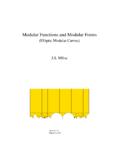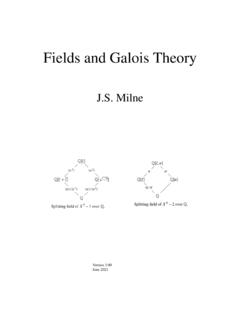Transcription of Algebraic Groups - James Milne
1 Algebraic GroupsThe theory of group schemes offinite type over a MilneVersion 20, 2015An Algebraic group is a matrix group defined by polynomial conditions. More abstractly,it is a group scheme of finite type over a field. These notes are a comprehensive modernintroduction to the theory of Algebraic Groups assuming only the knowledge of algebraicgeometry usually acquired in a first is still only a preliminary version, but is the last before the final version. It will berevised again before publication. In particular, repetitions, references to my website, andnotational inconsistencies will be removed; exercises and examples will be added; errorswill be corrected. The final version will be more tightly written, and will include 500 pages+ front matter. I welcome suggestions for improvements to the final version, which can besent to me at jmilne at information@misc{milneiAG,author={ Milne , James S.}}
2 },title={ Algebraic Groups ( )},year={2015},note={Available at },pages={528}} (July 31, 2014). First published on the web, 331 (January 29, 2015). Revised Parts A,B, 373 (December 20, 2015). Significantly rewritten and at photo is of a grotto on The Peak That Flew Here, Hangzhou, Zhejiang, 2014, 2015 paper copies for noncommercial personal use may be made without explicit permissionfrom the copyright book was written on a 2007 vintage Thinkpad T60p, the quality of whose keyboard and screen have not been one who attempts to unravel the story, theproblems are as perplexing as a mass of hemp witha thousand loose of the Red Chamber, Tsao book represents my attempt to write a modern successor to the three standard works,all titled Linear Algebraic Groups , by Borel, Humphreys, and Springer. More specifically,it is an exposition of the theory of group schemes of finite type over a field, based on modernalgebraic geometry, but with minimal has been clear for fifty years that such a work has been Borel,Chevalley, and others introduced Algebraic geometry into the theory of Algebraic Groups ,the foundations they used were those of the period ( , Weil 1946), and most subsequentwriters on Algebraic Groups have followed them.
3 Specifically, nilpotents are not allowed,and the terminology used conflicts with that of modern Algebraic geometry. For example, Algebraic Groups are usually identified with their points in some large algebraically closedfieldK, and an Algebraic group over a subfieldkofKis an Algebraic group overKequippedwith ak-structure. The kernel of ak-homomorphism of algebraick- Groups is an object overK(notk)which need not be defined the modern approach, nilpotents are allowed,2an algebraick- group is intrinsicallydefined overk, and the kernel of a homomorphism of Algebraic Groups overkis (of course)defined overk. Instead of the points in some universal field, it is more natural to considerthe functor ofk-algebras defined by the Algebraic advantages of the modern approach are manifold. For example, the infinitesimaltheory is built into it from the start instead of entering only in an ad hoc fashion through theLie algebra.
4 The Noether isomorphisms theorems hold for Algebraic group schemes, and sothe intuition from abstract group theory applies. The kernels of infinitesimal homomorphismsbecome visible as Algebraic group first systematic exposition of the theory of group schemes was in SGA 3. As wasnatural for its authors (Demazure, Grothendieck, .. ), they worked over an arbitrary basescheme and they used the full theory of schemes (EGA and SGA).3 Most subsequent authorson group schemes have followed them. The only books I know of that give an elementarytreatment of group schemes are Waterhouse 1979 and Demazure and Gabriel 1970. Inwriting this book, I have relied heavily on both, but neither goes very far. For example,neither treats the structure theory of reductive Groups , which is a central part of the noted, the modern theory is more general than the old theory. The extra generalitygives a richer and more attractive theory, but it does not come for free: some proofs are moredifficult (because they prove stronger statements).
5 In this work, I have avoided any appealto advanced scheme theory by passing to the Algebraic closure where possible and by anoccasional use of Hopf algebras. Unpleasantly technical arguments that I have not (so far)been able to avoid have been placed in separate sections where they can be ignored by all1 Another remorse concerns the language adopted for the algebrogeometrical foundation of the theory ..two such languages are briefly introduced .. the language of Algebraic sets .. and the Grothendieck language ofschemes. Later on, the preference is given to the language of Algebraic sets .. If things were to be done again, Iwould probably rather choose the scheme viewpoint .. which is not only more general but also, in many respects,more satisfactory. J. Tits, Lectures on Algebraic Groups , Fall anyone who asked why we need to allow nilpotents, Grothendieck would say that they are alreadythere in nature; neglecting them obscures our vision.
6 And indeed they are there, for example, in the kernel ofSLp! also assumed the main classification results of the old the most serious students. By considering only schemes Algebraic over a field, we avoidmany of the technicalities that plague the general theory. Also, the theory over a field hasmany special features that do not generalize to arbitrary exposition incorporates simplifications to the general theory from Allcock 2009, Dokovi c 1988, Iversen 1976, Luna 1999, and Steinberg 1998, 1999 and experienced reader is cautioned that, throughout the text, Algebraic group scheme is shortened to Algebraic group , nonclosed points are ignored, and a group variety is asmooth Algebraic , a group variety is group in the category of Algebraic varieties (geometricallyreduced separated schemes of finite type over a field). However, it is important to note thatvarieties are always regarded as special Algebraic schemes.
7 For example, fibres of maps areto be taken in the sense of schemes, and the kernel of a homomorphism of group varietiesis an Algebraic group which is not necessarily a group variety (it need not be smooth). Astatement here may be stronger than a statement in Borel 1991 or Springer 1998 even whenthe two are word for word the use the terminology of modern (post 1960) Algebraic geometry; for example, foralgebraic Groups over a fieldk;a homomorphism is (automatically) defined overk, not oversome large algebraically closed repeat: all constructions are to be understood as being in the sense of writing this book, I have depended heavily on the expository efforts of earlier following works have been especially useful to , Michel; Gabriel, Pierre. Groupes alg ebriques. Tome I: G eom etrie alg ebrique,g en eralit es, groupes commutatifs. Masson & Cie, Editeur, Paris; North-Holland PublishingCo.
8 , Amsterdam, 1970. xxvi+700 eminaire Heidelberg-Strasbourg 1965 66 (Groupes Alg ebriques), multigraphi e parl Institut de Math ematique de Strasbourg (Gabriel, Demazure, et al.). 407 expository writings of Springer, especially: Springer, T. A., Linear Algebraic edition. Progress in Mathematics, 9. Birkh auser Boston, Inc., Boston, MA, +334 , William C., Introduction to affine group schemes. Graduate Texts inMathematics, 66. Springer-Verlag, New York-Berlin, 1979. xi+164 of Ngo, Perrin, and Pink have also been , I note that the new edition of SGA 3 is a magnificent example is Chevalley s theorem on representations; see ..3 Contents6 Notations and conventions ..14 Foundations ..14 Prerequisites ..15 References ..15 Introduction ..151 Basic definitions and properties17aDefinition ..17bBasic properties of Algebraic Groups ..21cAlgebraic subgroups.
9 24dExamples ..27eKernels ..28fGroup actions ..30gClosed subfunctors: definitions and statements ..31hTransporters ..32iNormalizers ..33jCentralizers ..34kClosed subfunctors: proofs ..362 Examples; some basic constructions39aAffine Algebraic Groups ..39bAnti-affine Algebraic Groups ..42cHomomorphisms of Algebraic Groups ..43dProducts ..44eSemidirect products ..45fThe Algebraic subgroup generated by a map ..46gForms of Algebraic Groups ..49hRestriction of scalars ..50 Exercises ..523 Affine Algebraic Groups and Hopf algebras55aThe comultiplication map ..55bHopf algebras ..56cHopf algebras and Algebraic Groups ..57dHopf subalgebras ..58eHopf subalgebras Algebraic subgroups ofG..59fSubgroups Algebraic subgroups ofG..596gAffine Algebraic groupsGsuch dense inG: a survey ..60hAffine Algebraic Groups in characteristic zero are smooth.
10 62iSmoothness in characteristicp 0..64jFaithful flatness for Hopf algebras ..65 Exercises ..674 Linear representations of Algebraic groups69aRepresentations and comodules ..69bStabilizers ..70cEvery representation is a union of finite-dimensional representations ..71dAffine Algebraic Groups are linear ..72eConstructing all finite-dimensional representations ..72fSemisimple representations ..74gCharacters and eigenspaces ..75hChevalley s theorem ..77iThe subspace fixed by a group ..785 group theory; the isomorphism theorems81aTerminology on functors ..81bDefinitions ..82cThe homomorphism theorem ..84dExistence of quotients by normal subgroups ..85eProperties of quotients ..88fThe isomorphism theorem ..89gThe correspondence theorem ..90hThe category of commutative Algebraic Groups ..91iThe group of connected components of an Algebraic group .



















